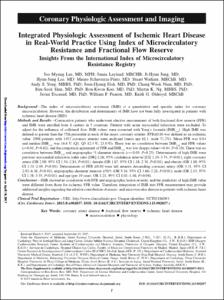KUMEL Repository
1. Journal Papers (연구논문)
1. School of Medicine (의과대학)
Dept. of Internal Medicine (내과학)
Integrated physiologic assessment of ischemic heart disease in real-world practice using index of microcirculatory resistance and fractional flow reserve: insights from the International Index of Microcirculatory Resistance Registry.
- Keimyung Author(s)
- Nam, Chang Wook
- Department
- Dept. of Internal Medicine (내과학)
- Journal Title
- Circulation: Cardiovascular Interventions.
- Issued Date
- 2015
- Volume
- 8
- Issue
- 11
- Keyword
- Coronary artery disease; Fractional flow reserve; Ischemic heart disease; Microcirculation; Physiology
- Abstract
- Background—The index of microcirculatory resistance (IMR) is a quantitative and specific index for coronary
microcirculation. However, the distribution and determinants of IMR have not been fully investigated in patients with
ischemic heart disease (IHD).
Methods and Results—Consecutive patients who underwent elective measurement of both fractional flow reserve (FFR)
and IMR were enrolled from 8 centers in 5 countries. Patients with acute myocardial infarction were excluded. To
adjust for the influence of collateral flow, IMR values were corrected with Yong’s formula (IMRcorr). High IMR was
defined as greater than the 75th percentile in each of the major coronary arteries. FFR≤0.80 was defined as an ischemic
value. 1096 patients with 1452 coronary arteries were analyzed (mean age 61.1, male 71.2%). Mean FFR was 0.84
and median IMRcorr was 16.6 U (Q1, Q3 12.4 U, 23.0 U). There was no correlation between IMRcorr and FFR values
(r=0.01, P=0.62), and the categorical agreement of FFR and IMRcorr was low (kappa value=−0.04, P=0.10). There was no
correlation between IMRcorr and angiographic % diameter stenosis (r=−0.03, P=0.25). Determinants of high IMR were
previous myocardial infarction (odds ratio [OR] 2.16, 95% confidence interval [CI] 1.24–3.74, P=0.01), right coronary
artery (OR 2.09, 95% CI 1.54–2.84, P<0.01), female (OR 1.67, 95% CI 1.18–2.38, P<0.01), and obesity (OR 1.80, 95%
CI 1.31–2.49, P<0.01). Determinants of FFR ≤0.80 were left anterior descending coronary artery (OR 4.31, 95% CI
2.92–6.36, P<0.01), angiographic diameter stenosis ≥50% (OR 5.16, 95% CI 3.66–7.28, P<0.01), male (OR 2.15, 95%
CI 1.38–3.35, P<0.01), and age (per 10 years, OR 1.21, 95% CI 1.01–1.46, P=0.04).
Conclusions—IMR showed no correlation with FFR and angiographic lesion severity, and the predictors of high IMR value
were different from those for ischemic FFR value. Therefore, integration of IMR into FFR measurement may provide
additional insights regarding the relative contribution of macro- and microvascular disease in patients with ischemic heart
disease.
Clinical Trial Registration—URL: http://www.clinicaltrials.gov. Unique identifier: NCT02186093.
(Circ Cardiovasc Interv. 2015;8:e002857. DOI: 10.1161/CIRCINTERVENTIONS.115.002857.)
Key Words: coronary artery disease ◼ fractional flow reserve ◼ ischemic heart disease
◼ microcirculation ◼ physiology
- Keimyung Author(s)(Kor)
- 남창욱
- Publisher
- School of Medicine
- Citation
- Stuart Watkins et al. (2015). Integrated physiologic assessment of ischemic heart disease in real-world practice using index of microcirculatory resistance and fractional flow reserve: insights from the International Index of Microcirculatory Resistance Registry. Circulation: Cardiovascular Interventions., 8(11), e002857–e002857. doi: 10.1161/CIRCINTERVENTIONS.115.002857
- Type
- Article
- ISSN
- 1941-7640
- Appears in Collections:
- 1. School of Medicine (의과대학) > Dept. of Internal Medicine (내과학)
- 파일 목록
-
-
Download
 oak-2015-0133.pdf
기타 데이터 / 1.4 MB / Adobe PDF
oak-2015-0133.pdf
기타 데이터 / 1.4 MB / Adobe PDF
-
Items in Repository are protected by copyright, with all rights reserved, unless otherwise indicated.